In 1984 the greatest British and Irish (and Kool and the Gang) musicians, many still great today, collaborated for the timeless Christmas song, Do they Know It’s Christmas?. So, fitting for 2020, let’s bring it back. Puto Bumbong is a traditional Filipino food during Christmas time. Unfortunately, many Filipino-Americans will not get their orders this year. Due to COVID restrictions and Stay at Home Quarantining, the neighborhood, home Filipina caterer is taking the season off. Fear not, I have a No Bamboo Puto Bumbong recipe that anyone can do. So sing it with me!
“It’s Christmas time, and there’s no need to be afraid. To make Puto Bumbong, with a recipe that’s right, no bumbong, it’ll be okay…”
Instant classic!!! In all seriousness, all jokes aside, we always pray for and help the least of these.
What is Puto Bumbong?
Other than having a cool name to say, Puto Bumbong is another variations of the Filipino food, Puto. In my Pumpkin Spiced Puto recipe, I mentioned other varieties of Puto. The recipe for making the puto of Puto Bumbong is actually easier compared to others but the process is a little more time consuming. Just keep in mind that there is a difference between difficult and time consuming.
The No Bamboo Difference
As you may know or may have guessed by now, “bumbong” refers to the bamboo tube that is traditionally used to steam the grinded rice blend. This piece of cooking equipment probably deters most Puto Bumbong fans to not make it at home. Not to mention, I have seen cool steamer contraptions that are used in the Philippines, that the bamboo tubes are attached to. Granted I live in Arizona, but I’m sure that this specialty steamer is not sold at stores.
With no cool steamer or access to bamboo (at least food grade), I figured to go to the next best thing. Growing up, my favorite Filipino treats was Suman (who doesn’t love anything that you dip in sugar?). Arguably a close cousin to the puto line of goodies. Both made of some form of rice and both steamed. A poplar way of steaming Suman is by wrapping it in banana leaves. Why not do this for Puto Bumbong?
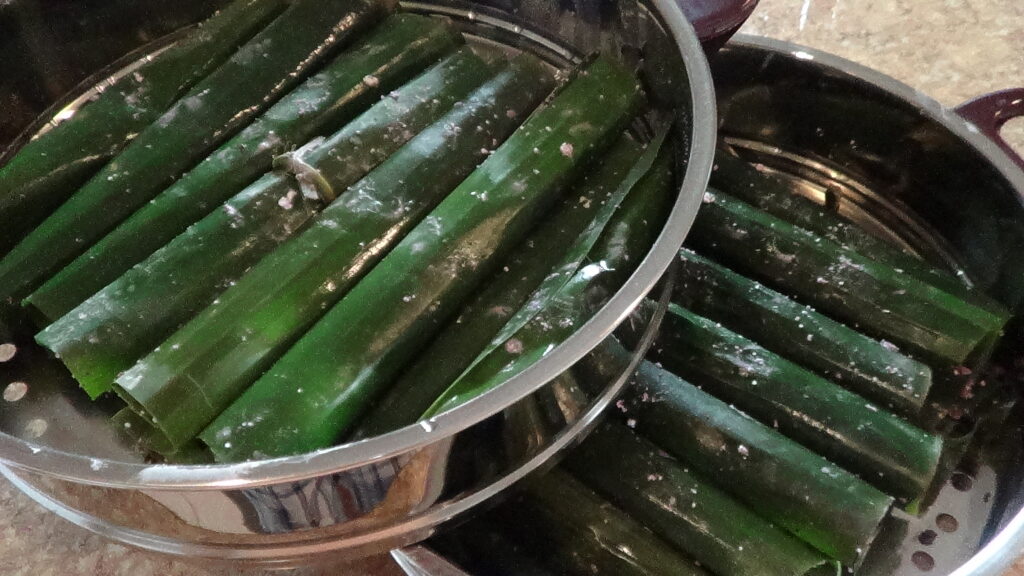
Ingredients
Figuring out the ingredient ratios for other puto dishes were difficult but, as I mentioned before, Puto Bumbong is more on the simple side. I was able to make mine with sweet black rice and sweet white rice. I was able to find both of these in Asian markets in Arizona, so I figure it shouldn’t be a problem in other states or cities with heavy Asian populations. These were the two that I was able to get:

In the freezer department of the Asian store, grab a package of banana leaves. No bamboo Puto Bumbong is all about improvising. Thank you to Tropics for thinking about and pretty much selling everything needed for Filipino cooking.
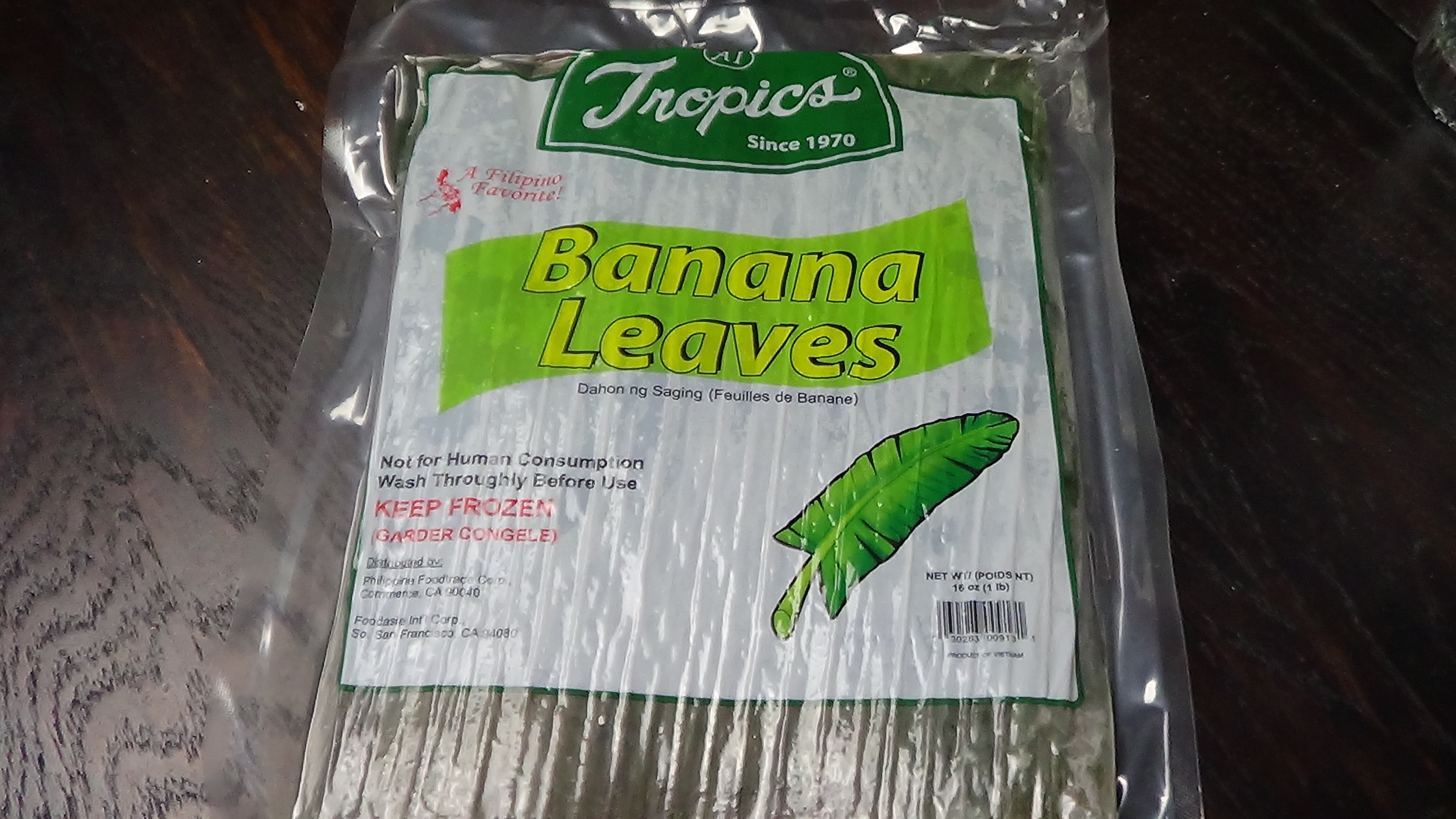
For our toppings, I went with the safe route of shredded coconut, butter and palm sugar. I would have love to use muscovado sugar but I couldn’t find it at our markets. If you can find granulated palm sugar, it would be easier to sprinkle on.
It may be easier to find palm sugar in its block or disc form. This is fine, but you would have to grind it up in a food processor or shave off pieces with a knife. I didn’t try it but I suppose it can be grated as well. If you put it in a food processor, scoop it out and let it dry a little on a plate. This was it will be easier to sprinkle on your Puto Bumbong. I love the mixed flavors of the butter and palm sugar.
If you can’t find fresh coconut shavings in your refrigerated section, frozen will do. Just don’t forget to defrost it before serving time.
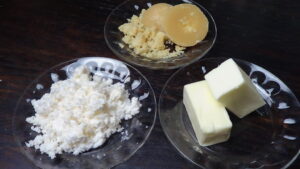
No Bamboo Puto Bumbong Instructions
The actual puto part is simple but time consuming. If you are planning to serve Puto Bumbong for Christmas, be sure to get started a couple of days in advanced. The biggest reason is because you are going to have to soak your rice for quite some time. When you soak your rice in water, the grains start to absorb the water. This not only will speed up the steaming time but it gives the rice a head start on the stickiness that you want in your Puto Bumbong. I’m sure that the water soaked grains is also easier on your food processor blades.
My recipe calls for 2 cups of each type of rice. This produced about 28 portions of Puto Bumbong. Perfect for a small party. I kept it at equal ratios so that you can easily increase or decrease the amounts for your situation. Again, keep in mind that it’s a time consuming dish if you are thinking of a snack just for you. Unless you want to eat a dozen or more, all by yourself.
The Ruling on the Soaking
I have soaked my rice for as long as a day and a half. That was only because I did not get a chance to grind it up when I originally planned. The recipe still came out fine. You can soak it as little as the time the grains will not soak up any more water. You will see that hours after soaking, your water level will drastically decrease. After that, add more water and give it more time to soak up more. Best case scenario, soak them after dinner and let it go overnight. Add more water when needed. If you start the grinding process the next afternoon or evening, you should be fine.
Drain water using a fine meshed colander or sieve. Depending on how big or efficient your grinder or processor is, consider grinding your rice in parts. This tends to be faster than grinding all of the grains at once.
Since I loved Suman growing up. I purposely don’t take the time to finely grind up the rice. Most of it will get finely grounded, but I like the contrasting textures. I even set some some of the soaked rice to the side to mix in some full grains. Because it is sweet rice and the fact that we soaked it, there will be enough sticky binding to keep it together. I think that I read somewhere that Puto Bumbong was originally made as full grains. Please feel free to comment on that below. Be sure to mix your rice contents well to achieve that contrasting texture in each Puto Bumbong and bite.
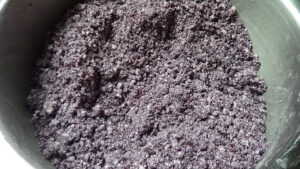
Prepping the Banana Leaves
One of the benefits of using frozen banana leaves is that by the time the package defrosts, the leaves are a whole lot more pliable to work with. It will be cut length wise with one side as the edge of the leaf and the other side with the center midrib.
I made my Puto Bumbong pieces about four to five inches long and about 1/2 to 3/4 inch thick. For that size, I cut pieces of leaves with about a with of four inches. Ultimately, the size of your steamer will dictate the size of your leaf cuts. Kitchen scissors are the best tool for this job. Banana leaves will be pretty fragile to work with. Some will naturally tear from the edge to the midrib. If that happens, save smaller pieces for presentation or some of them might be wide enough to roll up a Puto Bumbong. Cut enough pieces for the amount of Puto Bumbong that you are making.
Making the Leaf Even More Pliable
Once you have all of your pieces cut, trim off the mid rib. This will allow you to easily roll the leaf pieces around your rice mixture. Save the midribs for a cool little trick that might come in handy. Last thing is to thoroughly wash each piece. This can be easily done now that you have smaller pieces to work with. One at a time, I run them under warm water, rubbing them in between both hands. As I go, I place washed ones on a plate with a towel. It is not necessary to dry them. Now you’re ready for no bamboo Puto Bumbong!

Let’s Roll!
Grab one of your banana leaf sections. It doesn’t matter which side you use but you will find that the inside of the leaf (smoother side) is easier to roll when facing up. With a spoon or by hand line up some of your rice mixture about an inch away from where the midrib was located. For the size of my steamer, I was able to make my Puto Bumbong about five inches long. Don’t pack your mound up tight. You want the steam to be able to flow through your banana leaf tube. You can now trim the other side of the banana leaf, to give you about an inch of space on the other side of your mixture line.
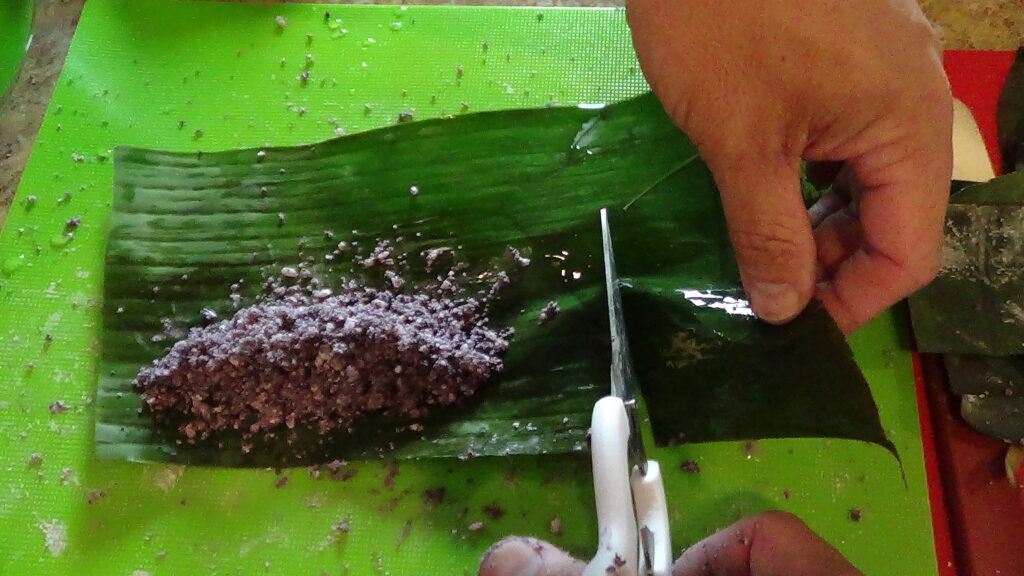
To roll, I found it easier to grab the edge closest to you and roll it over and past the mixture, pushing it back, creating a tube. Then continue rolling it over the remainder of the leaf. Remember, don’t roll it too tight. Place the roll in the steamer tray on the seam side. If you have a smaller leaf that might not hold its rolled position in the steamer, grab one of those midrib cuts and use it as a tie.
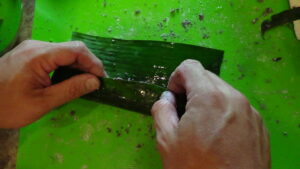
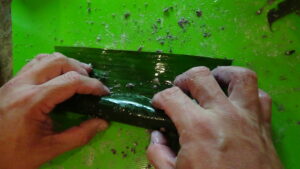


Depending on how many pieces you are making, remember to start boiling the water at some point while wrapping. If multitasking gives you anxieties, you can start the boiling process when you are done rolling.
Steaming Your No Bamboo Puto Bumbong
Get your water to a good boil on a high heat. Once your steam is good and ready, place your trays over the water and don’t forget the lid. I lower my heat down to about medium high, to get a steady boil and steam. I let it steam for fifteen minutes, but anywhere between 10 and fifteen will do. I went longer to compensate for the whole grains that I mix in.
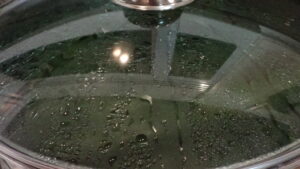
It is best to eat Puto Bumbong when they are on the hot side. Although, be sure to give them some time for at least the end of the banana leaf to cool off. Remove each piece from the steamer trays and place them on a cooling rack or baking pan. As soon as you can manage holding them, carefully roll them out of the leaves and onto your serving platter, with banana leaves for a nice display. They will be sticky when unrolling but manageable. Holding the edge of the leaf and rolling it out with a fork or butter knife works well. I didn’t try it but maybe spraying the leaves with a nonstick cooking spray would help.
Adding Your Toppings
Spread butter on each and then top it with shredded coconut. Sprinkle the palm sugar over the coconut. It is time to dig into your No Bamboo Puto Bumbong.
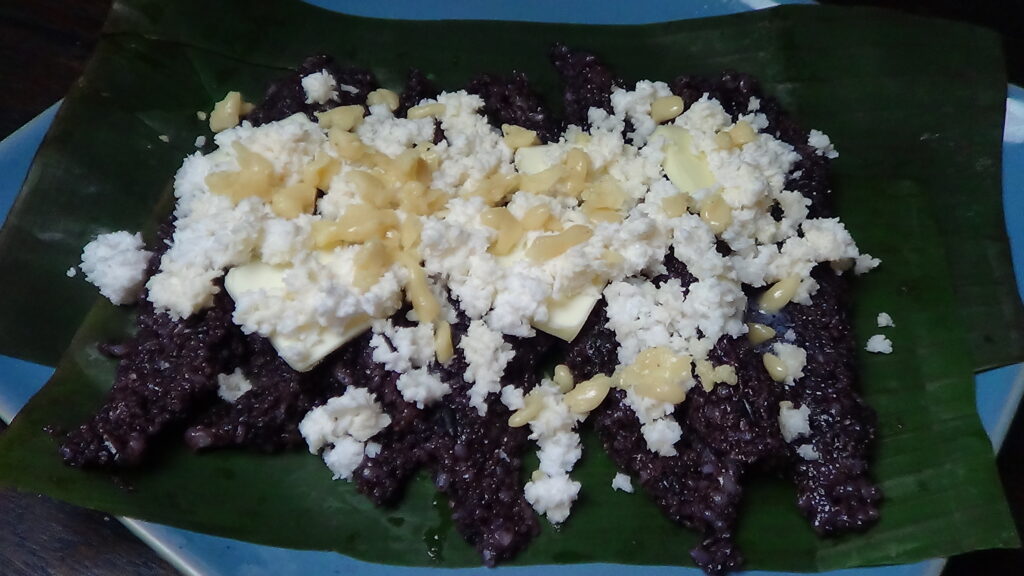
Enjoy and feel free to send us pictures of your No Bamboo Puto Bumbong!
Masayang Pagluluto!
Kain na tayo!

No Bamboo Puto Bumbong
Equipment
- Steamer Pot
- Food Processor
Ingredients
- 2 cups sweet black rice
- 2 cups sweet white rice
- 1 package banana leaves
- fresh shredded coconut for topping
- butter for topping
- palm sugar grated, shaved or ground for topping
- water for steamer
Instructions
- Soak sweet black rice and sweet white rice in water for 24 hours. Check occasionally for evaporation to add water accordingly.
- Drain water and grind rice in food processor.
- Trim Banana Leaves into 4" wide pieces. And cut off ribs. Make 28 pieces. Thoroughly wash each banana leaf piece.
- Spread a line of ground rice 1" from the edge, approx. 5" long and ½"-¾" thick. *Optional: Spray non-stick oil on leaves.
- Trim off excess banana leaves leaving 1" allowance on each side.
- Roll banana leaf around rice. Do not compact too tight, to allow the steam to go through the tube. Place onto steamer tray.
- Boil water at high temperature. Reduce heat to medium/high after it comes to a boil.
- Place steamer tray onto pot and steam for 15 minutes.
- Remove Puto Bumbong from steamer tray, allow to cool slightly enough to handle.
- Unroll Puto Bumbong onto serving tray and top with butter, fresh coconut and palm sugar.
